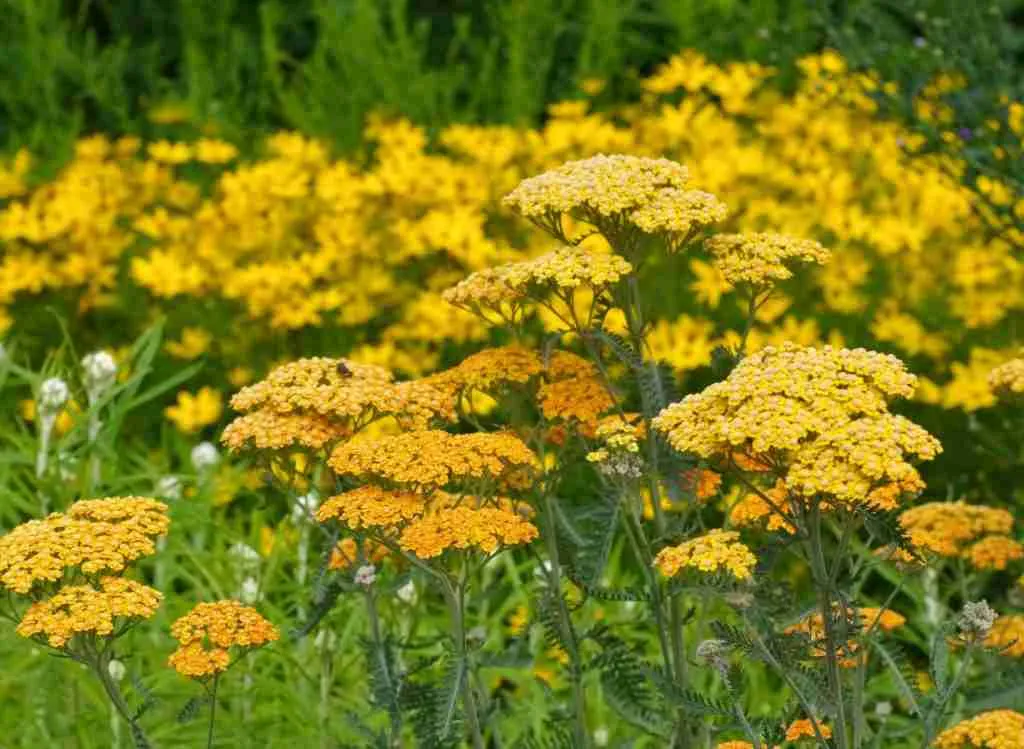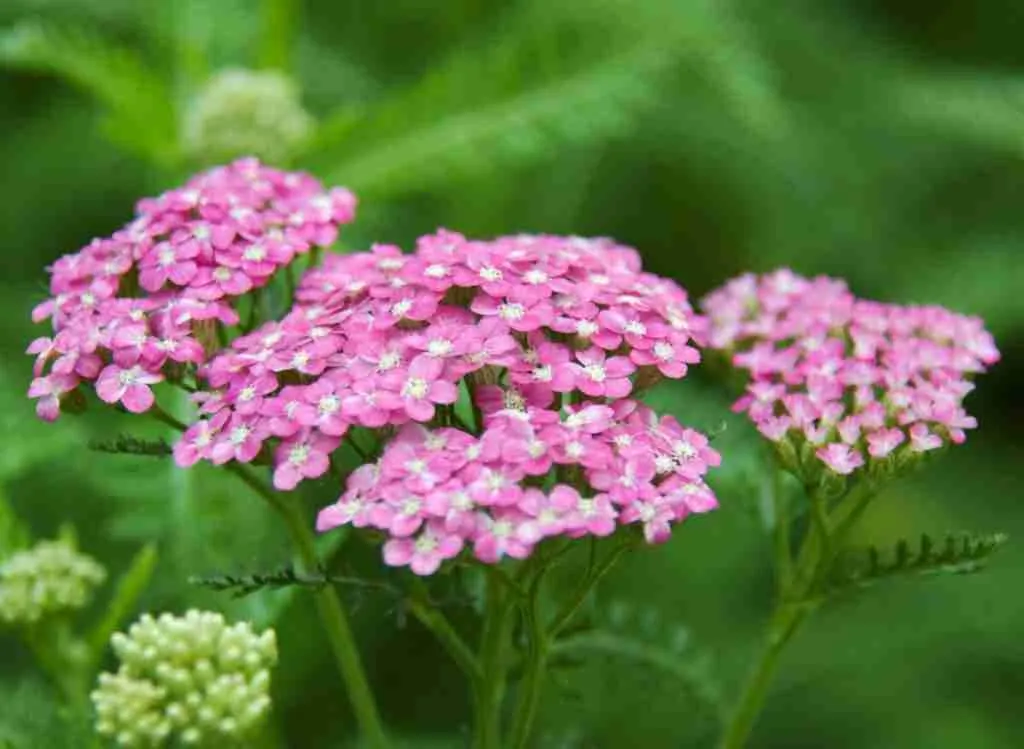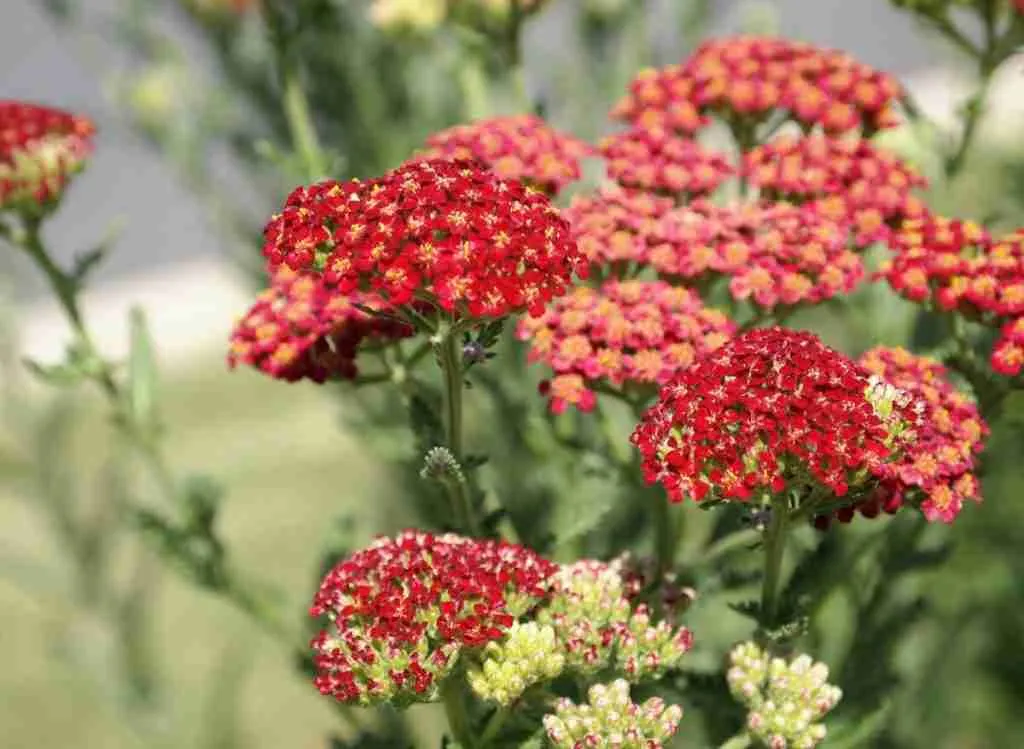
Yarrow (AKA Achillea millefolium) is a perennial flowering that is naturally found in grasslands and the forests of North America.
Yarrows come in various colors, including yellow, white, pink, orange, and dark red. Besides elevating the beauty of your garden, they have herbaceous and medicinal benefits and are good companion plants. So, how to use yarrow as a companion plant for your garden?
Read on to learn everything you need to know about yarrow, the best types of yarrow plants to add to your garden or property, the best companion plants for yarrow, and what makes yarrow plants excellent companion plants.
See also: Brassica Flower Vs. Hibiscus Flower: What Are The Differences?
Yarrow Plant Characteristics
Common yarrow or milfoil is a plant commonly known to gardeners for its delicate, aromatic, and feathery-cut leaves. Its genus, Achillea, was named after Achilles, who used plant extracts to treat soldiers’ wounds in the Battle of Troy.
And the name milfoil comes from the Latin word “millefolium,” which means “a thousand leaves.” Below is a snapshot of yarrow plant characteristics.
| Common Name | Yarrow, common yarrow, gordaldo, Western yarrow, milfoil, nosebleed plant, sanguinary, soldier’s woundwort, thousand-seal, thousand-leaf, devil’s nettle, dog daisy, and dog fennel |
| Genus name | Achillea millefolium |
| Plant family | Asteraceae |
| Plant Type | – Perennial – Ground Cover – Herb – Herbaceous Perennial – Wildflower – Poisonous |
| Well-draining, sandy, loamy clay | – 2 to 3 feet (60.96 to 91.44 cm) tall – 2 to 3 feet (60.96 to 91.44 cm) wide |
| Sun Exposure | Full sun (require at least six or more hours of direct sunlight a day) |
| Soil pH | 4 to 8 (alkaline, neutral and acidic) |
| Soil drainage | Well-draining, sandy, loamy, clay |
| Bloom Time | June to September (Summer) |
| Flower Color | – Cream/Tan – Orange – Gold/Yellow – Pink – Red/Burgundy – White – Purple/Lavender |
| Life Cycle | Perennial |
| Yarow Plant Attracts | – Bees – Pollinators – Butterflies – An excellent addition to a pollinator garden |
| Maintenance requirements | Low to medium |
| Spacing | 1- to 3 feet (30.48 to 91.44 cm) |
| Planting Depth | 1/2 inch (1.27 cm) for seeds |
| USDA Hardiness Zones | 3 to 9 |
| Tolerance | – Poor soil – Heat – Drought – Cold – Salt – Wind |
| It might cause potential minor skin irritation in humans and can be toxic to dogs, cats, and horses. | It might cause potential minor skin irritation to humans and can be toxic to dogs, cats, and horses. |
| Growth rate | Slow to moderate |
| Pests and Diseases | – Aphids – Botrytis blight – Powdery mildew – Mealybugs – Spittlebugs – Parasitic nematodes – Leaf spot – Root rot – Rust – Stem rot |
| Propagation | – Seed – Division – Tip cuttings |
| Landscape Uses | – Containers – Beds – Butterfly gardens – Deer resistant plantings – Meadows – Cut and dried – Mixed borders – Shoreline gardens – Xeriscapes – Ground covers – Perennial borders – Cottage gardens |
| Region Of Origin | Europe, western Asia, and North America |
Is Yarrow a Good Companion Plant?
Yarrows attract beneficial aphid-eating insects and pollinate bees in the garden. That’s why they are great companion plants for many fruits and vegetables. Yarrows benefit their nearby plants by attracting pollinating honeybees.
Apart from attracting pollinators, honey bees, and beneficial insects. The scent of the yarrow helps to keep harmful insects away. Thus, they protect not only themselves but also their companion plants. People have taken full advantage of this property of the yarrows plant.
Apart from all that, the yarrow companion plants also benefit from the company of yarrows in another way. The root secretions of yarrows activate the nearby plants’ disease resistance. This activation of disease resistance in the nearby plants deepens the companion plants’ fragrance, flavor, and color.
What is Attracted to Yarrow?
If you plan to grow yarrows in your garden, you may want to know in detail the things that attract yarrows. The beneficial insects that yarrows attract include bees, butterflies, and pollinators.
These beneficial insects check on small sap-sucking pests and aphids, making yarrow an excellent pollinator garden addition.
See also: Top 10 Beneficial Insects For Your Gardens
Best Yarrow Companion Plants
Yarrow is an excellent companion plant for numerous vegetable and fruit plants because it attracts pollinating bees and beneficial aphid-eating insects into your garden. Plant close to brassicas, tomatoes, aubergine, beans, and spinach. Yarrow is also helpful to aromatic herbs, including lavender, rosemary, basil, thyme, and oregano.
You know that the yarrow plant attracts the pollinators, such as honey bees, into the garden. Strawberries, apple trees, blueberries, and other fruit trees are among most of the yarrow companion plants that have benefited from this attracting-pollinator property of the yarrow plants.
According to the Clemson University Cooperative Extension Service, the following crops are the best-known companion plants of yarrows.
Perennials:
- Butterfly milkweed (AKA Asclepias tuberosa)
- Joe-Pye weed (AKA Eutrochium purpureum)
- Smooth penstemon (AKA Penstemon digitalis)
- Columbine (AKA Aquilegia canadensis)
- Redhot poker lily (AKA Kniphofia uvaria)
- Black-eyed Susan (AKA Rudbeckia fulgida v. fulgida)
- Split beard bluestem (AKA Andropogon ternarius)
Shrubs:
- American beautyberry (AKA Callicarpa americana)
- Evergreen holly (Ilex glabra and Ilex vomitoria, evergreen foliage, full sun)
- Common winterberry (AKA Ilex verticillata)
Small trees:
- Ozark witch hazel or witch hazel (AKA Hamamelis vernalis)
How To Use Yarrow As Companion Plants For Your Garden
- In dry climates, use low-growing yarrow forms as a soft-looking evergreen edging or an alternative to turfgrass.
- Yarow types with silver foliage and pale flowers, including Moonshine, are excellent additions to evening gardens alongside other plants with shimmery light-reflective foliage.
- Use yarrows with rich yellow or gold tones, including Coronation Gold, as a warm contrast to blue, purple, or violet perennials, such as speedwell (Veronica spicata), Geranium ‘Johnson’s Blue’, and salvias.
- Plant yarrow in pollinator gardens and other perennials that attract bees and butterflies, like butterfly weed and bee balm.
- Yarrows are ideal for low-water or xeriscape gardens because they tolerate drought.
- Yarrows with compact growth habits and eye-catching colors, like Paprika and Peachy Seduction, make splendid “thriller” plants in outdoor container combinations. With their large, flat-topped blooms looking like colorful sun parasols and their feathery foliage, they can add great texture to your garden.
- In a cool and dry place, tie fresh-cut bunches into bundles and hang them upside down by the stems to enjoy yarrow in dried flower arrangements because the dried flower heads will retain their color for months.
See also: Top 5 Of The Best Companion Plants For Lantana You Need To Know About!

Some Not-so-Good Yarrow Companion Plants
Cucumbers, melons, zucchini, pumpkins, and squash are better not to be grown nearby yarrows because they are susceptible to powdery mildew (a common fungus that affects a wide range of plants), and so is yarrow.
Don’t grow these crops near yarrow. Because if even one of them gets powdery mildew, there are fair chances that all of them (including yarrows) will be affected by this fungal disease, as it spreads very fast.
Some gardeners even recommend not growing coneflowers, bee balm, or butterfly weeds near yarrows. Because all of them differ in height, there can be issues like one crop blocking the sunlight for the other. If you think that you can manage this issue perfectly, you may grow coneflowers and butterfly weed nearby yarrows if you want to.
Can Yarrow Be Planted With Vegetables?
Vegetables, being the companion plants of yarrows, benefit from the beneficial-insects-attracting property of the yarrows and the insect-repelling abilities of the yarrows. Brussel Sprouts, Broccoli, Cauliflower, Cabbage, and other Brassicas are known to take benefits from yarrows.
Since some plants like Brassicas prefer to be kept cooler, growing nearby yarrows is best for them as yarrows provide shade to their companions.
Garlic and tomatoes are some other good yarrow companion plants. Since yarrows help in improving the growth of garlic, garlic is a good companion plant for yarrows. Yarrows attract pollinators, and tomatoes are the ones that take the most advantage of yarrows’ ability.
Where Should You Plant Yarrow in Your Garden?
Now that we have discussed what makes the yarrows good companion plants, what to plant near them, and whatnot, you may want to know where you should plant your yarrows in your garden. You can keep the following points in your mind while planting yarrow in your garden:
- Yarrow needs full sunlight to grow. Yarrows grow leggy in shade or partial sun. So, choose the area that receives full sunlight. It will encourage compact growth for both yarrow and yarrow companion plants.
- Well-drained soils are known to be best for yarrows. Yarrows can’t tolerate all the time; they need hot and dry conditions to thrive. We recommend loamy soil for growing yarrow.
- Don’t grow yarrow in soil that’s too enriched with nutrients. It may result in overgrowing of yarrows. They may be too tall in this way and will shadow their nearby plants more than they need to. You should plant them where the soil is average, and then you can give the plants a good start by supplementing the soil with a bit of compost.
How Do You Keep Yarrow From Spreading?
The only problem that the yarrows will give you is their ability to overgrow and take up the space of their nearby plants. What can you do to stop that? You can divide the yarrow plant to maintain its invasive growth. Dig up clumps of yarrows and put the leaves in your compost pile or plant it somewhere else.
Common yarrow spreads by underground stems and self-sowing.
- To control spreading by underground stems, you need to pull up new sprouts and the attached stem just below the soil surface. Remember to pull up fresh sprouts and the attached stem in early spring and during the growing season because it is easier to pull up spreading stems after rain when the soil is soft.
- Self-sowing is easy to control; you simply need to trim spent blooms. Also, do not forget to remove spent flowers in the yarrow to prevent plants from reverting to the parent form.
- As the National Gardening Association recommends, cut back yarrow plants to within 1 to 2 inches (2.54 to 5.08 cm) above the soil to eliminate places where pests can overwinter and give room for new green growth to emerge in spring.
Does Yarrow Come Back Every Year?
Generally, yarrow basal leaves stay green year-round in more temperate climates, but they will die back with a hard freeze in colder climates. Yarrow thrives all summer long, sending up 1- to 3-foot-tall flower stalks to form a dense mound of fern-like basal leaves.
The National Gardening Association suggests cutting back yarrow plants to within 1 to 2 inches (2.54 to 5.08 cm) above the soil line after the first killing frost in autumn. Cutting back yarrow plants in autumn will eliminate places where pests can overwinter and allow new green growth to emerge in spring. And sprinkle a 2-inch-thick layer of mulch around the plants to insulate the yarrow roots better.
See also: Top 5 Of The Best Companion Plants For Olive Trees You Need To Know About

Types of Common Yarrow to Select
- Coronation Gold is one of the best yellow yarrows for fresh-cut and dried flowers because compact plants produce dense, convex flower heads 3 to 4 inches across solid, well-branched stems. Zones 3-9.
- Moonshine has pale, flat, bright-yellow flower heads 2 to 3 inches across, with feathery silver-gray foliage. However, it is susceptible to foliar diseases and root rots during hot summers and does not tolerate wet soil. Zones 3-9.
- Achillea Schwellenberg has deep-gold flower heads on strong, well-branched stems and feathery silver foliage on a compact, upright plant. Zones 3-9.
- Appleblossom is three of the Galaxy hybrids that do well in the Mid-Atlantic region. They feature purple-pinkish flowers and are about 2 to 3 inches wide. Zones 3-9.
- Cerise Queen (A. millefolium) is a common yarrow cultivar with deep pink flowers and white centers. It grows between 12 to 36 inches (30.48 to 91.44 cm with deep pink flowers and dark green foliage. With this type of yarrow, you can brighten up your house’s garden beds and rooms. Zones 3-9.
- Gold Plate (AKA A. filipendulina) has beautiful and distinctive mustard-yellow flowers. It grows about six-inch flower heads. Its four- to five-foot stems that rise from mounds of fern-like silvery green basal leaves are equally impressive. Zones 3-9.
- Paprika (AKAK A. millefolium) is a common yarrow brick red cultivar with contrasting gold centers. They are 2 to 3 inches wide with blooms that gracefully fade to shades of pink. Zones 3-9.
See also: Is Holly-Tone Actually Good For Dogwood Trees?
Wrapping Up
Gardening is essentially learning how to grow different plants and get the most from your garden. And understanding how to use yarrow as companion plants for your garden offers many benefits, including increasing soil fertility and attracting beneficial bugs and pollinators.
Adding yarrow plants to your garden or property will elevate its beauty and increase its soil fertilizer, making yarrow an excellent plant companion.


